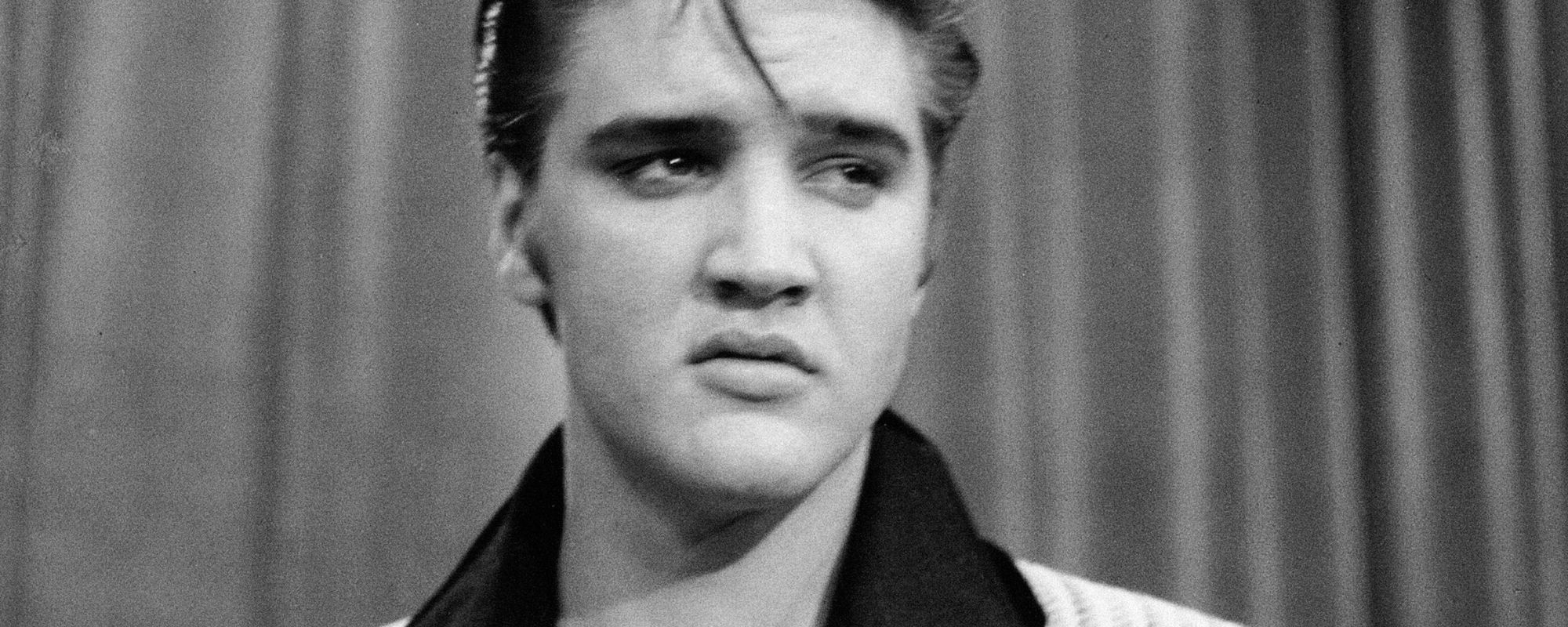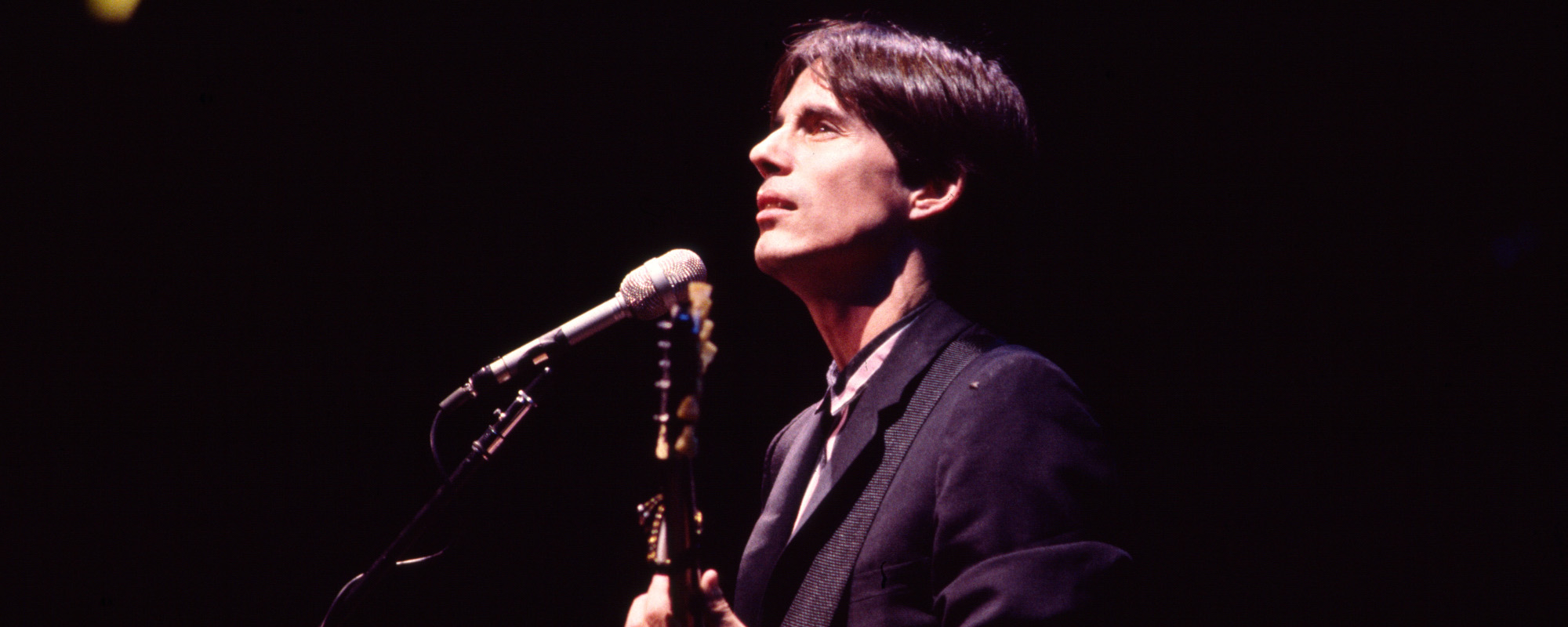From the summer of 1975 onward, the song “No Woman, No Cry” was the highlight at nearly every show that Bob Marley and the Wailers played. A recording of the song from a July 18, 1975 show at the Lyceum in London so well captured the feedback loop of excitement between the band and the audience that it became Marley’s first Top 10 single in England.
Videos by American Songwriter
A video of a June 4, 1977 show at the Rainbow Theatre in London allows us to see what was happening. The wiry lead singer in his denim jeans and patchwork shirt darts back and forth during the intro. He grabs the mic in his left hand, lifts his right above his head, shuts his eyes, tilts his bearded face upward and half pleads, half moans the hymnal chorus, repeating the phrase “No, woman, no cry” four times.
The verses tell the story of his teenage self, lounging around a bonfire in the courtyard of a Kingston public housing project with his friends, wondering what their slim prospects might amount to, trying to reassure his girlfriend that “everything’s gonna be alright.” By the time the final chorus rolls around, the title line is echoed by the three female singers and by the audience as well. Soon everyone in the hall is sitting by that bonfire, hoping against hope that the reassurance can overcome the tears.
Less than four years later, Marley died of cancer at the age of 36. But instead of diminishing after his death, his influence only grew larger. Released in 1984, Legend, a Bob Marley greatest hits collection that includes “No Woman, No Cry,” became one of the best-selling albums of all time. Last year marked the 75th anniversary of his birth and this year marks the 40th anniversary of his death, but the fascination with Marley’s abbreviated career remains as strong as ever.
Last fall, the Bob Marley YouTube channel offered a 12-part documentary series, Bob Marley: A Legacy, accompanied by a series of digital EPs offering rare mixes of his songs. Universal Music released a 12-disc box set, The Complete Island Recordings, in three different versions: on CD, on vinyl pressed at Marley’s old Tuff Gong headquarters in Kingston and on vinyl remastered at Abbey Road Studios in London. Each set included the nine studio albums, the two live albums released in his lifetime, and the Legend anthology. In addition, Marley’s June 13, 1980, concert in Dortmund, Germany, during his final tour, was released as a three-LP vinyl set, Uprising Live.
All this activity raises irresistible questions about the Jamaican native: What might have happened had Marley responded to his cancer sooner and returned to work with the disease in remission? What would the rest of his career have looked like? What was the source of his appeal while he was alive? What makes him the most famous entertainer from a developing nation even today? Is it his anti-colonial politics? His mystical, homegrown religion? His championing of marijuana? His singing? His onstage charisma? His great band?
All of these factors played a role, but the foundation for everything was his songwriting. Reggae has seen better singers, better guitarists, fiercer ideologues, more fervent spiritualists, but the genre has never seen a better songwriter. His closest competitors, Jimmy Cliff and Frederick “Toots” Hibbert, failed to produce half as many enduring songs, tunes that are still sung by everyone from the local reggae band at a “legalize pot” rally to the decked-out soul-jazz singer at a downtown nightclub.
“I would not say he was one of the greatest singers of all time,” says Maxi Priest, a Londoner with Jamaican parents and a singer with a dozen Top 50 British singles. “I wouldn’t put him in the same category as Dennis Brown and Alton Ellis in Jamaica or Marvin Gaye and Luther Vandross in the States. But I would say he had a way of putting lyrics together and knew how to use his voice to put them across. Bob had a way of making the song he was singing feel like it was your song, not just his.
“Bob has to be one of the greatest songwriters of all time. His songwriting has proved that it translates to every race and every country. I’ve traveled all over the world, and everywhere I go, I hear a Bob Marley song. He had that simplicity. He didn’t overcomplicate things. He was never too sappy. He always had a level of consciousness. His wording, his way of writing, was very simple, very easy, very country, like folk music. He had an art about him.”

It’s often forgotten that Marley was a country kid. He was born and raised in the small town of Nine Mile in the agricultural parish of St. Ann in Jamaica’s north-central region. He grew up picking mangoes and collecting fallen branches for the evening fire. Around that fire, the elders sang old hymns and folk songs. There were precious few radios, phonographs or even store-bought instruments.
This was his world until he moved to Kingston for good in 1957, when he was 12 years old. When he got to the city and heard the sound of American artists such as Ray Charles and Louis Jordan — and later the Impressions — Marley added these new influences to the bedrock of his rural childhood.
“Coming from the country,” explains Marley’s eldest son, Ziggy, “you have a whole different experience. You’re more connected to the earth. It’s not such a dog-eat-dog way of life. My father would say that when you were in the country, people would say, ‘Good morning, how are you?’ The guys from the country grew up with the patience of planting a seed and seeing it grow. The guys in the city didn’t have that.”
Like Cliff, Hibbert and Winston “Burning Spear” Rodney, Marley combined the spiritual optimism of his younger days up-country with the hardened wariness that resulted from his urban adolescence. Even more than his colleagues, Marley carefully balanced these two aspects, acknowledging the justified anger and frustration of the Jamaican poor while providing reason to keep believing in a better world to come.
“There are musicians and then there are songwriters,” says Jamaican pianist Monty Alexander, who released a jazz album of Marley compositions called Stir It Up in 1999. “But every once in a while, someone comes along who conjures up both words and music that capture your soul. Bob Marley was a rarity because he could do it with both words and music. He had the gift of melody as much as Cole Porter, George Gershwin or any of those guys. He could connect the old folk music he heard in the countryside with the American R&B he heard on the radio and with the rhythms that anticipated the one-drop rhythm of reggae.”
This is especially obvious in “No Woman, No Cry.” The title is sometimes misunderstood by American listeners as “Even if you don’t have a woman, you don’t need to cry.” But what it actually means is “No, my woman, don’t you cry.” The woman being addressed has every reason to cry, but the narrator does his best to calm her. Life is hard and the system unfair, but she shouldn’t give into despair. How can he convey both halves of that message in the same song?
If the chorus is the fulcrum upon which the song balances, the verses describe the bleak state of affairs in the present, while the bridge offers a brighter vision of the future. The verses tell the story of teenagers hanging out after dinner. It’s a universal story — it could happen at the shopping mall in suburban Maryland or in a convenience-store parking lot in rural New Mexico. It could also happen in a “government yard in Brooklyn,” as Wyclef Jean sang on the Fugees’ version, a Top 10 single in England. In the original version from late ’50s Jamaica, the scene takes place “in a government yard in Trench Town.”
Trench Town was a housing project built by the government after a 1951 hurricane wiped out the ramshackle shantytown in a low-lying area of Kingston. Three large concrete apartment buildings faced inward on each courtyard, and Marley, his Nine Mile pal Bunny Livingston and their new friends Peter Tosh and Rita Anderson would hang out in one of them. George Headley Robinson, an older guy who befriended the teens, tended the fire and cooked up a pot of cornmeal porridge to keep them warm as the evening grew chilly.
“Bob understood our problems and could simplify them in such a manner that a lot of us songwriters struggle with,” says Priest, who sang two songs on the 2001 tribute album, A Twist of Marley. “You begin a song, and you go round and round in circles for days trying to find words and lines that are strong enough and simple enough without being sappy. So many things have been done in song and so many things have been said, and you don’t want to repeat. But his stories are true life stories. I know those stories because we live a similar life in England. I sat by that fire. I ate that porridge. When he hits those chords for the hook, it all comes alive.”
Marley, Tosh and Livingston would go on to form a vocal group called the Teenagers, then the Wailing Rudeboys, then the Wailin’ Wailers and finally the Wailers. They started out imitating American R&B groups such as the Drifters and the Impressions, but soon they started writing their own songs and developing a distinctively Jamaican sound. In 1971, they celebrated their old neighborhood in their No. 1 Jamaican single, “Trenchtown Rock.”
“You had a lot of music coming out of Trench Town,” Ziggy says. “It was the Motown of Jamaica. That song is a celebration of not only him, Peter and Bunny, it’s also a celebration of Desmond Dekker, Alton Ellis and the Wailing Souls.” Tosh and Livingston left the Wailers in 1974 because they disliked international touring. Marley replaced their male harmonies with the female harmonies of the I-Threes, one of whom was his wife Rita Anderson Marley. But the three men remained friends.
“‘No Woman No Cry’ just has a great feel to it,” says Chris Blackwell, the founder of Island Records and the producer of most of Marley’s records. “It’s great when you hear it performed on stage because the audience would always sing the chorus. It had that quality of making you want to sing along to it. It captures that tension of trying not to cry because things are so bad because there’s not enough food to eat.”
As with all of Marley’s songs, the meaning here comes not just from the words but also the music. The chorus sounds like a hymn straight out of a Christian church. Marley and most of his friends and fellow musicians had adopted the Rastafarian religion, an Afro-centric reaction to Jamaica’s corrupt Anglican Church, which openly enabled the British colonialists and their homegrown collaborators. And yet when the Rastas wrote songs that called for a renewed spirituality, the music often echoed that of Anglican hymns, even if the theology did not. That’s the sound they associated with the higher plane.
“’No Woman, No Cry’ is an example of how Bob takes a simple chord progression,” Alexander explains, “just four chords, and turns it into … a song of hope. The verses are conversational, but the chorus is like a church hymn. A lot of Rastafarian music borrows from the Christian services. A Rastafarian might smoke a spliff, bang on the Nyabinghi drum and start singing ‘Amazing Grace’ and it becomes theirs. They learned in church that if you repeat a refrain like ‘Everything’s gonna be alright’ enough times, people will start to believe it.”
“History repeats itself,” Priest says. “We’re going through a similar situation as back then, with racism raising its ugly head. We can’t ignore the cry of people in oppression. That cry is going to go on a long time until we have equality. Wherever there’s war and crime and struggle, that cry is going to exist. So that song is going to always resonate. The art of it is the way he interpreted the lyrics coming from someone with that pain.”
But the song doesn’t merely echo the “cry” of an oppressed people. It balances that impulse against the promise of redemption — both spiritual and political. That key phrase in the bridge resurfaces in his 1977 song “Three Little Birds,” which promises, “Don’t worry ‘bout a thing, ‘cause every little thing gonna be alright.” A lot of songwriters can write in the plain language and down-to-earth stories of children and rural folk, and many can put deep thoughts into their lyrics. But few can do it at the same time, and that’s what makes Marley special.
“People like to think of Bob as one thing,” Ziggy adds. “Some people only like the positive songs like ‘One Love’ or ‘Could You Be Loved.’ They don’t want to see the revolutionary side of him. Or maybe they only like the activist for justice and don’t see the mystic. He was both.
“We all have that duality in us. We don’t have to be one thing. I feel a lot of people don’t explore that other side. Maybe it makes them uncomfortable. Maybe they’d rather keep him in a certain light. To each his own. If people want to go deeper, they can go deeper. Bob is still who he is, no matter. He’s both ‘Three Little Birds’ and ‘Black Man Redemption.’”
On Marley’s original recordings, the songwriting credit for “No Woman, No Cry” is listed as Vincent Ford, just as “Them Belly Full (But We Hungry)” is credited to Lecon Cogill, “Natty Dread” to Allan Cole and “Rebel Music (3 O’Clock Roadblock)” to Hugh Peart. But all of Marley’s biographers and family members insist that he wrote all these songs himself and gave the credit to his friends as part of a battle with his music publisher, Cayman Music, which tried to deny them their commission. As such, they must be considered part of his songwriting output as much as the songs he publicly claimed.
Our best glimpse into Marley’s songwriting is “Redemption Song.” Though he did record the number with a full band, the best known version has just his voice and his fingers lightly brushing the strings of his Ovation acoustic guitar. This is how he presented songs to his musicians — with the words, chords and melody already in place, already capable of moving the listener.
“It’s like a version from early in the songwriting process,” Ziggy says. “That sound of him on the guitar, that’s how the songs were written. It’s a very deep song. It came to light after he had passed away, so that song has that emotional connection for me. Its melancholy feeling dominated my days after he passed. It captured how we all felt. The words are obviously important, but there’s also a spiritual, emotional thing that comes from the melody and connects to my experience as a child.”
Here again is the dramatic tension between the reality of injustice and the belief in deliverance. The first verse is devoted to the slave trade that brought Africans from their homeland to the Western Hemisphere, an experience he makes real by imagining himself crossing the ocean in the “bottomless pit” of a “merchant ship,” only to be sold “minutes” after landing on a foreign shore. The second verse addresses not physical bondage but “mental slavery,” the invisible chains that allow the rulers to “kill out prophets while we stand aside and look.” The latter phrase is borrowed from Jamaican-born Black Power activist Marcus Garvey, a prophet to the Rastafarians.
Out of the anguish of the verses with their IV-III-II-I chordal descent into hell comes the shining light of the chorus, rising on the V and falling softly on the I. The lyrics open up from claustrophobic brooding of the verse with the invitation to all his friends: “Won’t you help me sing these songs of freedom?”
“His music was spiritual, and lyrically he’s talking to people who are not as fortunate as some of us,” says Alexander. “He’s telling the guy who’s going through hell, having a hard time, to not give up. He’s not talking about guns and revolution. He’s talking about a revolution in the mind. You put that together with rhythms, and there’s nothing better. American college students were fascinated by this guy coming out of the bush with a spliff bigger than they’d ever seen, but then they discovered the deeper Bob, as deep as the Beatles and the Stones.”
What If Bob Marley Had Defeated Cancer and Had Lived Twenty More Years?
Read our future fiction.
Photo Credit Adrian Boot












Leave a Reply
Only members can comment. Become a member. Already a member? Log in.